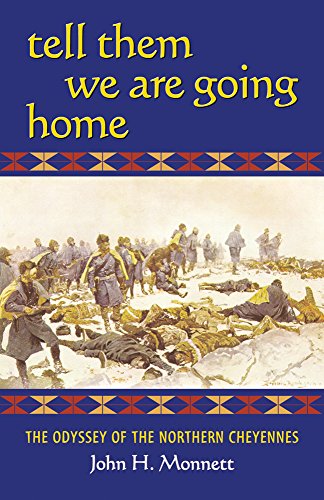Frank Leslie's Illustrated, Feb. 15, 1879, depicts the Cheyenne Outbreak.
Tell Them We Are Going Home
The Odyssey of the Northern Cheyennes
by John H. Monnett
University of Oklahoma Press, 2004.
This is the first scholarly book-length history of the full exodus of the Northern Cheyenne, from their escape from the Darlington Agency in Oklahoma to the establishment of the Northern Cheyenne Reservation in Montana.
The 1,500-mile, months-long epic odyssey was a poignant episode in American history, like the Trail of Tears and the Nez Perce War, and a full chronicle of its story is long overdue.
John Monnett's history follows the trail of the Northern Cheyennes from the end of their participation in the Great Sioux War of 1877 to the formal establishment of the Northern Cheyenne Reservation in 1900.
In the aftermath of the Great Sioux War of 1876-1877, the Native American tribe known as the Northern Cheyennes surrendered to the U.S. Army. But unlike their allies in the war, the Lakota Sioux, the Cheyennes were not given a reservation near their homeland on the northern plains. Instead, they were transported to the Indian Territory in what is now Oklahoma and settled on the Darlington Agency with their kinsmen, the Southern Cheyenne.
The homesick Northern Cheyennes languished in the sultry, alien environment, dying in droves from starvation and disease. In just one year, their population fell from 937 to 353.
The surviving tribal leaders Little Wolf and Dull Knife rebelled. With more than 300 men, women, and children, they bolted from Darlington Agency on the evening of September 7, 1878, and set out overland for for the hills of Montana.
U.S. government troops quickly pursued the Northern Cheyenne exodus, but for more than a month Little Wolf and Dull Knife skillfully maneuvered their party through the western prairies of Oklahoma, Kansas, and Nebraska. Several times soldiers caught them only to be frustrated each time by Indian deployment and resistance.
After crossing the Platte River in Nebraska, Dull Knife and Little Wolf separated. Little Wolf, with about 60 followers, wanted to continue moving north and join the Lakota leader Sitting Bull in Canada.
The second group, led by Dull Knife, decided to try to obtain refuge with the Lakota chief Red Cloud. With this in mind, they set out for the Red Cloud Agency. Red Cloud and his people, however, had recently been relocated into the Dakota Territory and only soldiers remained near the old agency.
Dull Knife and about 150 followers were apprehended by an army patrol and surrendered on October 24, 1878. Imprisoned at Fort Robinson, they waited while the government decided their fate. Dull Knife asked that the Cheyennes be allowed either to join Red Cloud in the Dakota Territory or to remain somewhere in their homeland. But Kansas officials were trying to extradite several members of the tribe to stand trial for alleged crimes committed during their flight through the state and Washington officials insisted that the Cheyennes return to Oklahoma.
Dull Knife remained adamant. The Cheyennes would not return to Darlington Agency. Captain Wessels, Commanding Officer at Fort Robinson, imprisoned the Indians in the barracks and attempted to starve them into submission.
By the night of January 9, 1879, the impasse had come to a point of crisis, and the Cheyennes broke out of the barracks. Weapons they had hidden earlier were used to shoot the guards, and while some of the men held off the soldiers, the remaining Cheyennes fled in the dark.
Military patrols acted quickly again, killing and capturing over half of the Indians. A desperate running battle was waged on the fort's snow-covered parade ground between the fleeing Cheyennes and the pursuing soldiers.
At least 26 Cheyenne warriors were killed during the night and some 80 women and children were recaptured. Others managed to follow the banks of the White River, scale the cliffs and escape.
On January 22, most of the remaining escapees were killed or taken prisoner at a camp on Antelope Creek northwest of Fort Robinson. Dull Knife and part of his family were among the few that managed to get away, and eventually made their way to refuge with Red Cloud.
News of the heroic and tragic "Cheyenne Outbreak" triggered a sympathetic outpouring of indignation from the American public and in 1883 the government relented and established a Northern Cheyenne Reservation in southeast Montana.

